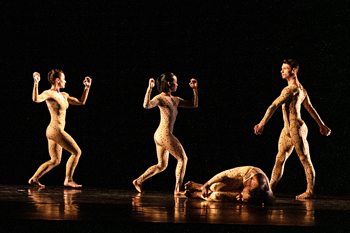Dance: Paul Taylor at the Joyce
By Dawn Lille
arttimesjournal July 24, 2022
 Aureole - Maria Ambrose and Devon Louis Photo by Steven Pisano |
After Martha Graham died there was a bitter and expensive two- year court battle over who owned her works. Others learned from this: Merce Cunningham’s will provided for the dissolution of his company and a foundation to set his works.
Paul Taylor began to incorporate dances by other outstanding American choreographers into his company’s repertory in addition to commissioning pieces by young creators. He chose Michael Novak, a dancer in his troupe, to replace him as artistic director.
On July 1, 2018, Novak began a planned year long “shadowing” that would lead to a gradual understanding and assumption of the role of guiding the Paul Taylor Dance Company. But Taylor died in August of that year and Novak was left to head one of the greatest modern dance companies, led for 64 years by one of dance’s greatest choreographers.
Covid and its consequences created additional problems for the artistry, future and very survival of the company and its “family,” as many alumni consider themselves. The recent series at the Joyce Theater (June 14-19), a smaller house then that in which this strong, daring group customarily performs, revealed some of the treasures of the past and possible paths to the future.
 Tracer - L-R Madelyn Ho, Kristin Draucker, Jessica Ferretti —Photo by Steven Pisano |
Novak, who is not a choreographer, has followed Taylor’s thinking in commissioning works from emerging choreographers and named Lauren Lovette, a former New York City Ballet dancer turned choreographer, as the Taylor choreographer in residence. Two works new to the company at the Joyce wereA Call For Softer Landings, a New York premiere by Peter Chu, and Hope Is The Thing With Feathers, a world premiere by Michelle Manzanales. I saw only the former, but heard praise for the latter.
Chu, who free lances, is based in Las Vegas where, with his project based company chuthis he concentrates on reaching youth in the area, many of whom feel isolated and ignored. This would explain his choice of music (Liquid Liquid, Duke Ellington, Julia Wolfe and Joan Armatrading) often loud and assaulting, but often melodic as well, the vocal outbursts, the bright lights and the use of 15 dancers as a group power, sometimes shown as opposing forces of anger. This piece, with its sculpting use of the upper body, would communicate well with the audience for which he often creates, its episodes expressing anger and seeing it in others. One could question its suitability for the Taylor group, but the dancers appeared to physically enjoy performing it.
In an interesting historical approach, Novak’s choice to mine the company archives resulted in several examples of works created by a young and experimenting Taylor, all of which gave an insight into the choreographer he would become.. This material was chosen with care, in an attempt to relate it to the present and to the interim years. It was a kind of biography that revealed which experiments were tried and rejected and which remained in some form.
 Events II - L-R Eran Bugge and Jada Pearman Photo by Steven Pisano |
Events II (1957), for two dancers dressed in simple every day dresses designed by Robert Rauschenberg, who were seated most of the time, changing direction but never facing each other. Their calm stillness was accompanied by the sound of rain. The audience looked at them, but they were looking also. One could not help wondering what the two were thinking. One member of the audience was heard to ask, “Where is the dance?” The answer was in the stillness.
Tracer (1962), with music by James Tenney that is quirky, but fun, contains a set composed of a wheel and costumes, both by Rauschenberg, who was part of the experimental crowd at the time. The four dancers moved in fast little lateral hops across the stage and frequently used hip thrusts, both of which are seen in later works.
Profiles (1979) used the most solid “weight into the earth” exploration. The bodies of the four performers always moved in strong profiles, connecting with the floor and almost exhaling their power into space, with a palpable awareness of each other.
 Profiles L-R Eran Bugge, Madelyn Ho, Alex Clayton, John Harnage —Photo by Ron Thiele |
In selecting Aureole as the Taylor “classic” for the season Novak chose an early piece . Still in the company repertory, it has entered that of many ballet companies and contains much of the quintessential Taylor style that comes through even in the diversity of his many creations. A plotless work that premiered in 1962 at the American Dance Festival in Connecticut, it reveals so many of the possibilities contained in the force of human movement. The work constantly explores and shapes space with a seemingly careless sense of abandon. The fleeting gestures, moments of stillness, the appearance of little hops and the rich arm movements all became pat of his ever- expanding palette.
In choosing Handel’s music for this rich suite of dances, Taylor was defying modern dance dogma of the time, which emphasized contemporary music. He had started on his path of individuality. To share Aureole is a joy and to view it on a program of early explorations was thought provoking.
This is a time of risk taking and more experimenting in an unstable world. As ever, some things will work and others will be discarded. The future is unclear and getting there challenging. I look forward to sharing the Paul Taylor Dance Company’s choices.
dawnlille@aol.com
